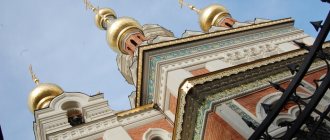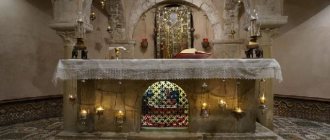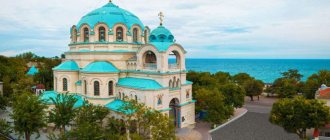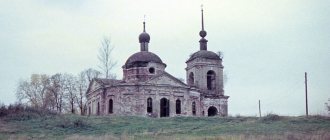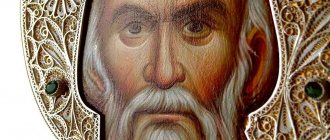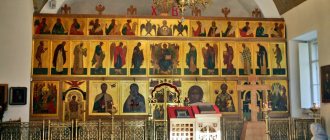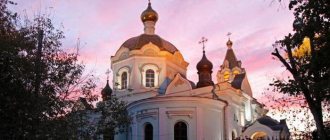“In my native village of Bereza”: About the homeland of St. Nicholas of Japan
| Cross in the village of Bereza |
“A holiday in my native village of Bereza,” begins a page in the diaries of St. Nicholas of Japan with these words.
“My relatives must remember me too.” They also remember Equal-to-the-Apostles Nicholas in Moscow. From October 24 to December 31, 2006, an exhibition dedicated to the 170th anniversary of the birth of the great Russian missionary is being held in the house Tatian Church of Moscow State University (B. Nikitskaya St., 1). Ivan Dmitrievich Kasatkin was born on August 1/13, 1836 in the village of Bereza, Belsky district, Smolensk province. The father of the future missionary, Deacon Dimitri, had four children: the first-born Gabriel, who died in infancy, daughter Olga, second son Ivan and youngest son Vasily (he became a priest and served in the city of Syzran).
When Vanya was five years old, the family lost their mother and their older sister, whose husband served as a deacon in a rural church, began to look after the children. The future saint studied at the Belsk Theological School, then at the Smolensk Theological Seminary, and upon graduation, as the first student in 1856, he entered the St. Petersburg Theological Academy on public account. On June 21, 1860, Ivan Kasatkin took monastic vows with the name Nikolai, on June 29 he was ordained a hierodeacon, and the next day - a hieromonk. Then followed a long road to Japan. Hieromonk Nikolai spent the winter from 1860 to 1861 in the city of Nikolaevsk, where Bishop Innokenty (Veniaminov) of Kamchatka, the future saint of Moscow, mentored the young shepherd.
Saint Nicholas returned briefly to his homeland only twice: in 1869–1870 to petition for the establishment of the Russian Ecclesiastical Mission in Japan and in 1879–1880 in connection with episcopal consecration and raising funds for the needs of the mission.
The saint's diaries preserve his memories of his meeting with his relatives, the only one during his half-century of service in Japan.
“The view of Bereza - the green roof of the Church... I immediately went to the Bereza River to wash off the dirt of the road,” writes Bishop Nicholas on June 26, 1880. “Nature alone redeemed melancholy and consoled me.”
The missionary served a memorial service for his deceased father and talked lovingly with his relatives. I visited my friend Sergei Alexandrovich Rachinsky, who later became a trustee and donor of the Japanese Church, as well as the spiritual father of one of the students at the Tokyo Seminary. Bishop Nicholas also visited the Skrydlovs, the family of the famous admiral, who lived nearby.
A few days later in Bereza there was a festive service on the day of the holy apostles Peter and Paul.
“The morning is most beautiful. I attended Matins in Church. The service is earnest. He still sang in the choir, writes Bishop Nikolai. “After Matins I went for a swim... The view of Birch is wonderful - the mirror surface of the river... After mass I liked the groups of festively dressed peasants and peasant women.”
Bishop Nicholas really wanted to give something to his relatives and growing nephews, but they understood the needs of a missionary who was busy raising funds for the young Japanese Church. “The unselfishness of relatives is amazing, everywhere there is only: “It’s not necessary, you need it yourself,” the archpastor notes with some chagrin.
In July 1880, Bishop Nicholas returned to Japan and since then has never come to Russia again. On March 28, 1906, by decree of the Holy Synod, Bishop Nicholas of Revel was elevated to the rank of archbishop. However, this recognition of the bishop’s missionary feat during the Russian-Japanese War was perceived by him with humility and a certain amount of humor: “So it is true that I have been renamed archbishop. Well, okay” (May 10/23, 1906).
Vladyka Nicholas never forgot about his homeland: he always wrote letters to his relatives and friends, from his own funds he sent gifts for significant celebrations and weddings to all his nephews and great-nephews, without forgetting any of them.
Birch became especially close and dear to the missionary in the last years of his life. “I placed orders for surplices, books for the seminary and for the church school in Bereza,” writes 70-year-old elder Nikolai in August 1909.
In 1910, Bishop Nicholas became seriously ill. Weakness of heart could not tear the archpastor away from his daily service, sermons, translations, instructions to the clergy and parishioners. According to the memoirs of Bishop Sergius (Tikhomirov), the bishop did not lose his presence of mind even during his illness and remained a witty person: “I can imagine... Come into my room... And I am dead... You turn pale... “Kawamura, water!” - shout... And then, having calmed down: “Kawamura, light the candles!” We sing: “With the saints...”[1].
“A holiday in my native village of Bereza,” begins a page in the saint’s diaries on April 23/May 6, 1910 with these words. “My family must remember me too.” There are fairs there, a lot of people and a lot of fun.” And indeed, news from home did not keep me waiting long: “From my native village of Bereza I received a photograph of a church and another of a school named after Sergei Alexandrovich Rachinsky by my name, because I send 200 rubles a year to it. A group of 50 boys and girls from Fr. Pyotr Sokolov in the middle is very pretty: their faces are meaningful, they are dressed decently...” (October 17/30, 1910).
Saint Nicholas, through incredible daily labors and selfless care for his flock, managed to nurture an almost independent Local Church. 175 churches and 8 large cathedral temples were opened, and the clergy consisted of 40 Japanese clergy.
In Tokyo itself, in addition to the Resurrection Cathedral, there were several churches; services were conducted in Japanese. At the mission there was a theological seminary, which received the official status of a secondary educational institution in Japan, a girls' school, an orphanage, a publishing house, and a library. Saint Nicholas, with God's help, managed to accomplish a rare and almost impossible task for one person - translating the Holy Scriptures. During the last 17 years of his life, during daily morning and evening classes, all the books of the New Testament were translated and repeatedly verified. Then followed the Lenten Triodion, the Festive Menaion, the Book of Psalms, the Irmologium.
On February 3/16, 1912, at 7 pm Tokyo time, His Eminence Nicholas, Archbishop of Japan, passed away. On February 4, all of Japan knew about the missionary’s death. “The Christians of the city of Tokyo flocked to the mission; non-Orthodox Christians expressed their sympathy... Some with a bow, and some with a business card, hurried to the mission and those who had not yet accepted the teachings of Christ, and not only ordinary citizens, but also princes, and counts, and viscounts, and barons, ministers and non-service people, – writes Bishop Sergius. “But the height of honor that Japan paid to Vladyka Archbishop Nicholas was that the emperor
Japan... sent a magnificent and huge wreath of fresh flowers to the bishop’s coffin.
And he sent it not in secret!.. Having accepted the wreath and responding to the words of the message with gratitude, we laid a wreath at the head of the saint... The Emperor
of Japan himself crowned the head of the saint of God with victorious flowers!.. Inside the wreath are two hieroglyphs: “On-Si”, i.e.
the highest gift
... And all the Japanese saw, read, and reverently bowed their heads before the wreath!.. Having begun in mortal danger, Vladyka Nicholas ended his work in Japan with approval from the heights of the
throne
”[2].
***
| Temple in the village of Mirny |
Archbishop Nicholas's relatives never forgot about his missionary service and endless kindness towards his family.
Only the youngest of the granddaughters of Saint Olga’s elder sister did not receive a wedding gift from the Bishop in 1911 and was very offended. The girl did not know that the archpastor was then mortally ill and had not conducted any correspondence for a long time. After the repose of the Bishop, all his great-nephews, and then their children and grandchildren, who dispersed to many cities in Russia, tried to go to church and every Sunday submitted notes of repose, with the name of Archbishop Nicholas in the first place.
In 1970, the first evangelist of Orthodoxy in Japan, Archbishop Nikolai (Kasatkin), was canonized. A service and akathist were compiled for St. Nicholas of Japan in Russian and Japanese. A chapel of the Tokyo Cathedral was consecrated in honor of the bishop, and a few years later the Japanese congregation erected a chapel next to the cathedral. In the city of Maebashi, Tokyo Metropolis, a temple was built in the name of St. Nicholas.
The Russian Orthodox Church also honors the memory of its son, who headed to the distant land of the Rising Sun.
In the homeland of Bishop Nicholas in the village of Bereza, on August 1, 1998, on the site of a former temple, demolished to the ground by Hitler’s artillery, a five-meter cross with inscriptions in Russian and Japanese was erected. On February 16, 2000, on the day of remembrance of Equal-to-the-Apostles Nicholas, Archbishop of Tver and Kashinsky Victor performed the ceremonial laying of the foundation of the temple in the village of Mirny located near Bereza. And three years later, the first liturgy took place in the newly built two-tier church. Metropolitan Daniel of Tokyo presented the revived parish of the village of Bereza with an icon of their extraordinary fellow countryman with a particle of the relics of the saint.
In Moscow, in the parish of St. Sergius of Radonezh in Bibirevo, the lower chapel of the church in honor of the Council of All Saints of Moscow is dedicated to St. Nicholas of Japan. Since Christmas 2005, regular services have been held here.
The shepherd’s compatriots sing to him and to many of God’s chosen Russian missionaries, who have become famous throughout the world: “Having heard the voice of the Gospel and inflamed with apostolic zeal, we rushed into the teaching of unfaithful tongues, the blessedness of Equal-to-the-Apostles Kuksha, Leonty, Stephen and Guria, Herman of Alaska, and St. Father Nicholas of Japan, and venerable Innocent, the apostle of the great Siberian country and the pioneer of enlightenment across the sea of existing new countries in America. In the same way, together with all the others who have labored in the gospel of Christ, you are more deservedly blessed” (stichera on “praise”, service to All Saints who have shone in the lands of Russia).
Metochion of the Russian Orthodox Church in Japan
The first seeds of faith on Japanese soil were sown by hieromonk (later archbishop) Nikolai (Kasatkin), who came to Japan in 1861 as rector of the church at the Russian consulate in Hakodate.
For more than 50 years, Saint Nicholas worked in Japan in the field of Christ, enlightening the Japanese with the light of Truth. His services as the founder and first Primate of the Japanese Orthodox Church are widely known not only in Japan and Russia, but throughout the world.
The blessed death of Archbishop Nicholas followed on February 16, 1912 , and in 1970 he was canonized by the Russian Orthodox Church with the title “equal to the apostles.”
Archbishop Nicholas was succeeded by Metropolitan Sergius ( Tikhomirov), who was sent to Japan by the Synod of the Russian Orthodox Church in 1908 . The fate of Metropolitan Sergius was full of sorrows: in 1940 , in connection with the entry into force of the “Law on Religious Organizations”, according to which foreigners could not stand at the head of a religious organization, he was removed from the post of Primate of the Japanese Orthodox Church, and a few months before his His death, which followed on August 10, 1945 , Metropolitan Sergius was accused of espionage by the Japanese authorities without any reason and spent about a month in prison.
In November 1946, the Moscow Patriarchate sent two bishops to Japan, but the headquarters of the occupation forces under the command of General MacArthur did not want to let them into Japan and invited a bishop from the American Metropolis.
A group of clergy and laity who disagreed with this separated from Nikolai’s group and created a separate “True Orthodox Church,” headed by Bishop Nikolai Ono and Archpriest Anthony Takai .
There were very few believers in this small Church, but its pride was that it still considered the Russian Orthodox Church to be its Mother Church and kept the Rules of the Church and Sacred Tradition intact.
On September 30, 1957, the Synod of the Russian Orthodox Church at its meeting officially recognized this Church as the true Japanese Orthodox Church. It was also decided that it is the successor to the Japanese Orthodox Church, founded by Archbishop Nicholas.
At first, the prayer room of this Church was located on the territory of Nikolai-do (the former Russian school was converted into it), and later it was moved to a separate building in the Shinjuku area. Protopresbyter Anthony Takai . In 1965 , he died at an old age and was succeeded by Archbishop (at that time a priest) Nikolai Sayama , who was ordained Bishop of Tokyo and Japan on December 10, 1967
In April 1970, the Nikolai-do group returned to the jurisdiction of the Russian Mother Church and began its existence as the Holy Autonomous Japanese Orthodox Church. Bishop Vladimir was appointed Bishop of Tokyo and Japan. Thus, complete reconciliation took place between the two Churches.
In connection with this, by the decision of the Holy Synod, in April 1970, a new stage of activity began for the Japanese Orthodox Church, governed by Bishop Nicholas Sayama, now as a Metochion of the Russian Orthodox Church. Bishop Nikolai Sayama was relieved of his duties as Primate of the Japanese Orthodox Church and Head of the Japanese Mission and appointed rector of the Compound.
May 22, 1979 , on the day of the Transfer of the Relics of St. St. Nicholas the Wonderworker, the Compound was registered as a religious legal entity with a change in name from the “Japanese Orthodox Church” to the “Compound of the Russian Orthodox Church of the Moscow Patriarchate in Japan .
Since July 1991, the rector of the Compound is Archpriest Nikolai Katsuban.
Tel./Fax: (81-3) 3947-9404 Official website: https://www.sam.hi-ho.ne.jp/podvorie/

